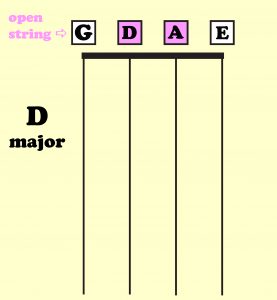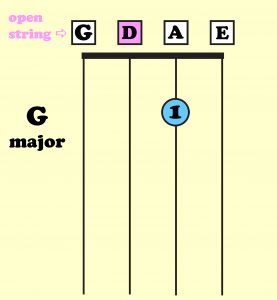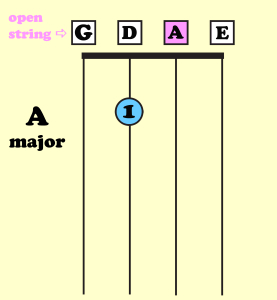Overview
Did you know that you can play chord backup on the fiddle and violin?
This is a role normally played by the guitar, mandolin or piano. But you can do it on fiddle with two-note double stops chords.
Why learn chord backup?
Knowing how to play chord backup will help you to play with others in jam sessions and performance. Instead of always playing the melody or soloing, you can play a supporting role. This is done by playing the chords of a song with the rhythm of the song.
Chord backup also helps you to harmonize melodies. In other words, you can play more expressively by adding notes to the melody.
A Simple Approach to Learning Chord Backup on Violin
Here’s the easiest way to get started with playing chord backup. Learn three chords and then learn twenty songs with those chords.
Let’s Practice
First step: Learn and master D, G, A chords.
D Major

G Major

A Major

Next, learn and master the transitions between chords:
- D to A
- D to G
- G to A
Tip: practice alternating the fingerings for these without even playing. Just practice the movement. Then do it with the bow.
These are basic two-chord progressions.
Next, add rhythms to those two-chord progressions.
- Train
- Hoedown
- Triplets
I-IV-V Progressions
Next, practice simple I-IV-V progressions. Start with single bows, then eventually add the same rhythms.
D/G/A/D
D/G/A/A
D/G/D/A
This sets the stage for playing three-chord songs.
Play Three-Chord Songs
Then learn and play backup on twenty songs that use only those three chords.
Start with familiar tunes like “This Land Is Your Land” by Woody Guthrie. By the way, he wrote like 1000 songs that use just three chords.
Sticking with just three chords trains you in the basic process of figuring out chord backup.
Two ways I can help you on your fiddle journey 🎻
- Sign up for the Free Two-week Trial. You’ll get full access to all courses and group lessons. Plus, I’ll send you some free lessons tailored to your current skill level.
- Sign up for the FiddleHed newsletter below, then get high-value tips and lessons delivered to your inbox.
